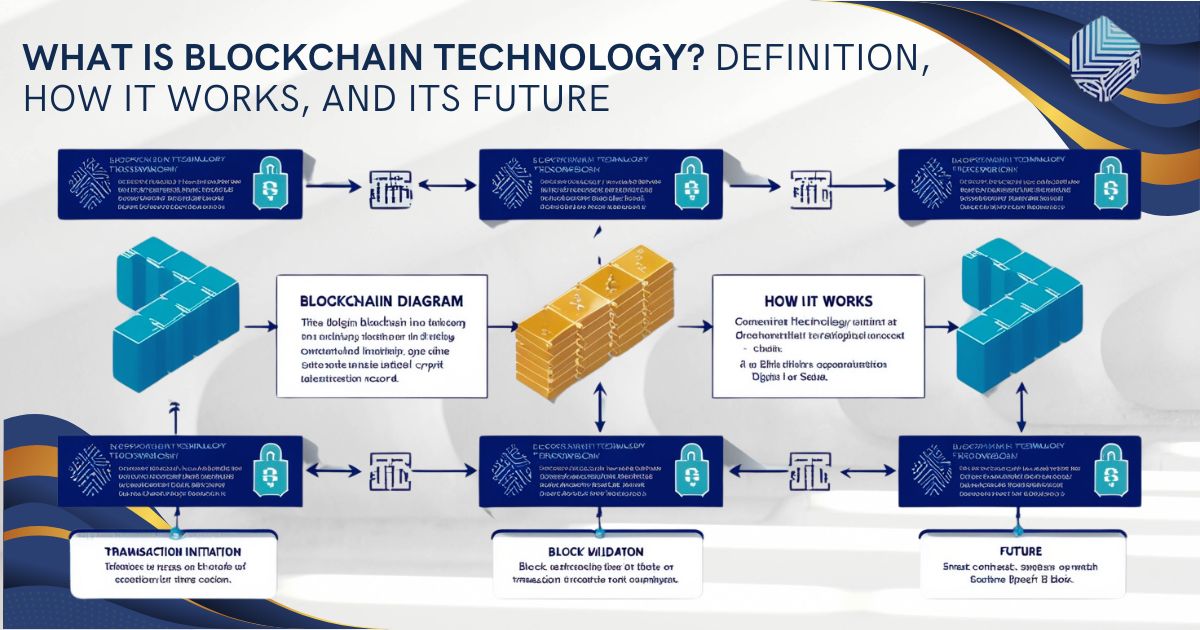What is Blockchain Technology?” Blockchain innovation is changing the way we think about information administration, security, and exchanges. In this comprehensive direct, we’ll investigate blockchain innovation, how it works, its suggestions, and how you can learn about it. We’ll too jump into the most recent advances driving blockchain advancements.
What is Blockchain Technology?
Blockchain innovation is a decentralized computerized record framework that records exchanges over numerous computers. This innovation guarantees that records are permanent and straightforward, giving a secure way to oversee and confirm exchanges without depending on a central authority.
Definition of Blockchain Technology
At its center, blockchain innovation is a chain of squares, each containing a list of exchanges. Each piece is connected to the past one through a cryptographic hash, making a safe chain of information to alter. This decentralized record is kept up by an arrangement of computers (hubs) that collectively approve and record transactions.
How Blockchain Innovation Works
To get how blockchain innovation works, let’s break down its components and processes:
- Blocks: Each square in the blockchain contains a set of exchanges. These pieces are made and successively included in the chain.
- Transactions: An exchange is a record of an activity, such as a budgetary exchange, put away inside a block.
- Hashing: Each square contains a one-of-a-kind cryptographic hash that is produced based on the block’s substance and the hash of the last piece. This hash guarantees the keenness of the data.
- Consensus Component: Blockchain systems utilize agreement components to concur on the legitimacy of exchanges. Common instruments incorporate Confirmation of Work (PoW) and Verification of Stake (PoS).
- Decentralization: Instead of depending on a central specialist, blockchain innovation disperses information over a arrange of hubs. Each hub keeps up a duplicate of the blockchain, guaranteeing that the framework remains operational indeed if a few hubs fail.
- Immutability: Once information is included in a square and the square is affirmed by the organizer, it cannot be changed or erased. This unchanging nature guarantees that exchange history is lasting and transparent.
Explain Blockchain Technology
Key Highlights of Blockchain Technology
- Decentralization: Dispense with a central specialist’s requirement by disseminating information over different nodes.
- Transparency: All members in the arrangement can see the blockchain, giving straightforwardness and accountability.
- Security: Cryptographic calculations and agreement instruments are secure against extortion and unauthorized changes.
- Immutability: Once a piece is included, it cannot be changed, guaranteeing the astuteness of the data.
Types of Blockchains
- Public Blockchains: Open to anybody and kept up by a decentralized organization of hubs. Cases incorporate Bitcoin and Ethereum.
- Private Blockchains: Confined to particular members and controlled by a central specialist or consortium. Utilized for venture applications.
- Consortium Blockchains: A crossover of open and private blockchains, where different organizations collaborate to oversee the blockchain.
How to Learn Blockchain Technology
 How to Learn Blockchain Technology
How to Learn Blockchain Technology
Learning blockchain innovation can be an energizing and fulfilling journey. Here are a few steps to get started:
1. Get it the Basics
Start by familiarizing yourself with the essential concepts of blockchain innovation, such as squares, hashing, and agreement instruments. Various online assets, counting articles, recordings, and instructional exercises give a foundational understanding.
2. Take Online Courses
Many stages offer courses on blockchain innovation. See for trustworthy courses that cover points such as blockchain essentials, shrewd contracts, and decentralized applications (dApps). A few prevalent stages incorporate Coursera, Udacity, and edX.
3. Connect Blockchain Communities
Participate in online gatherings and communities related to blockchain innovation. Websites like Reddit, Stack Trade, and specialized blockchain gatherings give openings to inquire questions, share information, and interface with specialists in the field.
4. Work on Projects
Hands-on involvement is vital for learning blockchain innovation. Begin by working on little ventures or contributing to open-source blockchain ventures. This viable involvement will offer assistance to strengthen your understanding and skills.
5. Remain Updated
Blockchain innovation is quickly advancing. Remain educated about the most recent patterns, innovations, and advancements by taking after industry news, blogs, and investigative papers.
Implications of Blockchain Technology
 Implications of Blockchain Technology
Implications of Blockchain Technology
Blockchain innovation has far-reaching suggestions for different sectors:
1. Finance
Blockchain is revolutionizing the monetary industry by empowering secure and straightforward exchanges. Cryptocurrencies like Bitcoin and Ethereum are based on blockchain innovation, giving an elective to conventional money-related systems.
2. Supply Chain Management
Blockchain upgrades straightforwardness and traceability in supply chains. By recording each supply chain step on a blockchain, companies can guarantee item realness and diminish fraud.
3. Healthcare
In healthcare, blockchain innovation can safely store persistent records, streamline information sharing, and make strides in the exactness of therapeutic research.
4. Voting
Blockchain offers a secure and straightforward way to conduct races. By recording votes on a blockchain, the astuteness of the voting prepare can be guaranteed, lessening the hazard of extortion and tampering.
5. Genuine Estate
Blockchain innovation streamlines genuine bequest exchanges by giving a straightforward and unchanging record of property proprietorship and transactions.
What Are the Most Recent Innovations Driving Blockchain?
Several rising advances are driving progressions in blockchain:
1. Layer 2 Solutions
Layer 2 arrangements, such as the Lightning Organize for Bitcoin and Hopeful Rollups for Ethereum, point to moving forward versatility and diminishing exchange expenses by handling exchanges off-chain and settling them on the primary blockchain.
2. Interoperability Protocols
Interoperability conventions empower diverse blockchains to communicate and share information. Ventures like Polkadot and Universe are working on arranging interconnected blockchains.
3. Decentralized Fund (DeFi)
DeFi applications use blockchain innovation to offer money-related administrations such as loaning, borrowing, and exchanging without mediators. Stages like Uniswap and Aave are driving the DeFi revolution.
4. Non-Fungible Tokens (NFTs)
NFTs are interesting advanced resources that speak to possessing a particular thing or piece of substance. Blockchain innovation guarantees the genuineness and provenance of NFTs, which are picking up notoriety in craftsmanship, gaming, and entertainment.
5. Zero-Knowledge Proofs
Zero-knowledge proofs permit one party to demonstrate to another that an articulation is genuine without uncovering any extra data. This innovation improves protection and security in blockchain transactions.
Utilize Cases of Blockchain Technology
 Utilize Cases of Blockchain Technology
Utilize Cases of Blockchain Technology
1. Computerized Personality Management
Blockchain innovation can give a secure and decentralized way to oversee advanced characters. Conventional strategies of character confirmation are frequently vulnerable to extortion and information breaches. Blockchain offers a more secure elective by permitting people to control their data and share it specifically with confirmed parties.
2. Mental Property Protection
In the domain of mental property (IP), blockchain can be utilized to ensure copyrights and licenses. By recording IP resources on a blockchain, makers can build up a clear proprietorship and demonstrate the inventiveness of their work. This can offer assistance to anticipate unauthorized utilization and guarantee that makers get appropriate compensation.
3. Keen Contracts
Smart contracts are self-executing contracts with the terms of the assertion composed into code. These contracts naturally implement and execute the terms of an understanding when predefined conditions are met. Shrewd contracts kill the requirement for middle people, decrease the chance of debate, and streamline complex transactions.
4. Charity and Donations
Blockchain innovation can upgrade straightforwardness and responsibility in charitable organizations. By recording gifts and support allotments on a blockchain, organizations can give givers a clear see of how their commitments are utilized, guaranteeing that stores are going through as intended.
5. Vitality Sector
In the vitality division, blockchain can encourage peer-to-peer vitality exchange. People and businesses can utilize the blockchain to exchange overabundance of vitality specifically with others, diminishing dependence on conventional vitality providers and advancing the utilization of renewable vitality sources.
Challenges and Restrictions of Blockchain Technology

Challenges and Restrictions of Blockchain Technology
While blockchain innovation offers various benefits, it too faces a few challenges and limitations:
1. Scalability
Scalability remains a critical challenge for blockchain innovation. As the number of exchanges develops, blockchains can be gotten to be slower and more costly to utilize. Arrangements such as Layer 2 advances and sharding are being created to address these adaptability issues.
2. Vitality Consumption
Some blockchain systems, especially those utilizing Verification of Work (PoW) agreement components, devour noteworthy sums of vitality. This has raised natural concerns and calls for more energy-efficient options, such as Confirmation of Stake (PoS).
3. Administrative Uncertainty
Blockchain innovation works in a quickly advancing administrative environment. Governments and administrative bodies are still deciding how to address issues related to cryptocurrencies, information protection, and computerized resources. This administrative vulnerability can affect the selection and improvement of blockchain solutions.
4. Complexity and Usability
The complexity of blockchain innovation can be a boundary to section for numerous clients. Creating user-friendly interfaces and applications is basic for making blockchain innovation more open to a broader audience.
5. Interoperability
While different blockchain systems offer interesting highlights, interoperability remains a challenge. Guaranteeing that diverse blockchains can communicate and share information consistently is significant for realizing the full potential of blockchain technology.
Future Patterns in Blockchain Technology
1. Integration with Manufactured Insights (AI)
The integration of blockchain innovation with AI has the potential to improve information security and protection. AI can be utilized to analyze blockchain information for experiences and forecasts, whereas blockchain can give a secure and straightforward way to oversee and confirm AI-generated data.
2. Blockchain in Government and Open Services
Governments are investigating the utilization of blockchain innovation for different open administrations, counting voting, arrival enrollment, and welfare dissemination. Blockchain can progress straightforwardness, diminish debasement, and streamline regulatory processes.
3. Advancement of Modern Agreement Mechanisms
New agreement components are being created to address the impediments of existing ones. For cases, Verification of Specialist (PoA) and Assigned Confirmation of Stake (DPoS) are being investigated as choices for PoW and PoS, advertising diverse trade-offs in terms of security, adaptability, and vitality efficiency.
4. Blockchain in the Web of Things (IoT)
Blockchain innovation can upgrade the security and interoperability of IoT gadgets. By recording IoT information on a blockchain, gadgets can safely trade data and perform exchanges without the requirement for a central authority.
5. Progressions in Security Technologies
Privacy-focused blockchain advances, such as zk-SNARKs (Zero-Knowledge Brief Non-Interactive Contentions of Information), are being created to improve information protection and security. These advances permit for private exchanges and information sharing while keeping up the judgment of the blockchain.
Also Read: How Many Blockchain Technologies Exist? A Complete Overview
Advantages of Blockchain Technology
| Advantage | Explanation |
|---|---|
| Security | Blockchain uses cryptographic techniques to secure data. |
| Transparency | All transactions are visible to participants in the network. |
| Decentralization | Reduces the risk of central points of failure. |
| Immutability | Once data is recorded, it cannot be altered or erased. |
| Efficiency | Reduces the need for intermediaries, speeding up transactions. |
Disadvantages of Blockchain Technology
| Disadvantage | Explanation |
|---|---|
| Scalability Issues | Blockchains can become slow and expensive as they grow. |
| High Energy Consumption | Some consensus mechanisms, like PoW, require significant energy. |
| Complexity | The technology can be complex and difficult for beginners. |
| Regulatory Uncertainty | Blockchain technology faces regulatory challenges in many regions. |
| Data Privacy | Although transparent, the visibility of all transactions may pose privacy concerns. |
Comparison of Blockchain Consensus Mechanisms
Also Read:What is Blockchain? Definition, Examples, and How it Works
Conclusion
Blockchain innovation is a progressive improvement with the potential to change a wide run of businesses. Understanding what blockchain innovation is, how it works, and its suggestions gives a strong establishment for investigating its applications and learning openings. As the innovation proceeds to advance, remaining educated about the most recent progressions and patterns will offer assistance you exploring its complexities and capitalizing on its benefits.
Whether you’re interested in blockchain’s effect on funds, supply chain administration, or developing innovations, this direct has given a comprehensive outline of the technology’s definition, workings, and future potential. Grasping blockchain innovation can open entryways to unused advancements and openings in the computerized age.
FAQs About What is Blockchain Technology? Definition, How It Works, and Its Future
1. What is blockchain innovation utilized for?
Blockchain innovation is utilized for secure record-keeping, empowering cryptocurrencies, progressing supply chain straightforwardness, overseeing computerized personalities, and more.
2. How does blockchain innovation work?
Blockchain innovation works by recording exchanges in pieces, which are connected in a chain. Each square is approved by an arrangement of hubs and secured through cryptographic algorithms.
3. What are the benefits of blockchain technology?
The benefits of blockchain innovation incorporate decentralization, straightforwardness, security, and permanence, which offer assistance to avoid extortion, improve information keenness, and decrease dependence on intermediaries.
4. How can I learn blockchain technology?
You can learn blockchain innovation through online courses, partaking in blockchain communities, working on ventures, and remaining upgraded with industry developments.
5. What are a few later progressions in blockchain technology?
Recent headways incorporate Layer 2 arrangements for versatility, interoperability conventions, decentralized back (DeFi) applications, non-fungible tokens (NFTs), and zero-knowledge proofs for improved privacy.
This article gives a comprehensive see of blockchain innovation, its workings, suggestions, and future improvements. If you have any more questions or require encouraging subtle elements, feel free to inquire!


